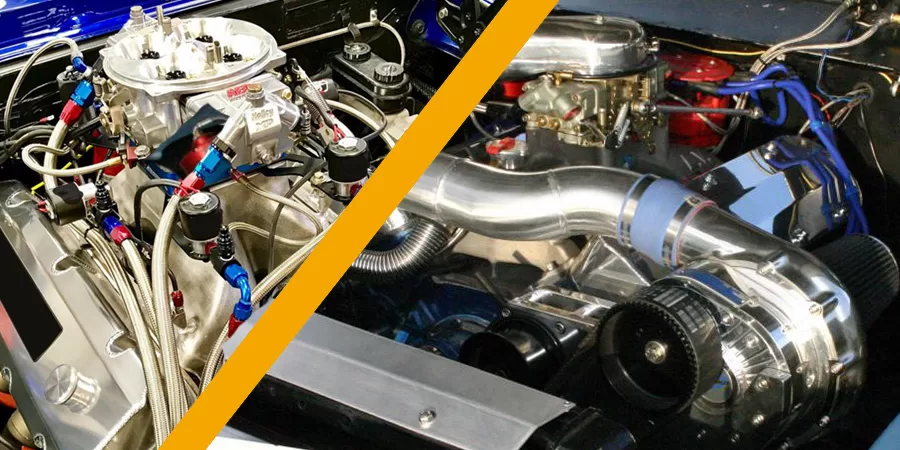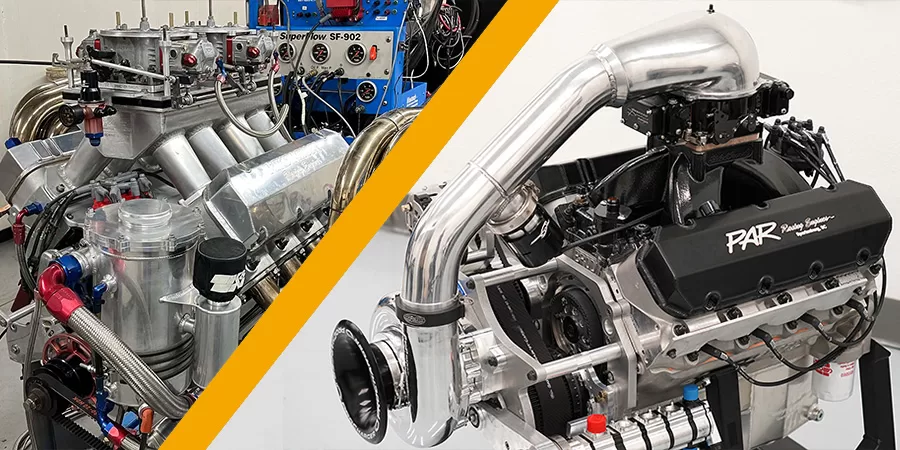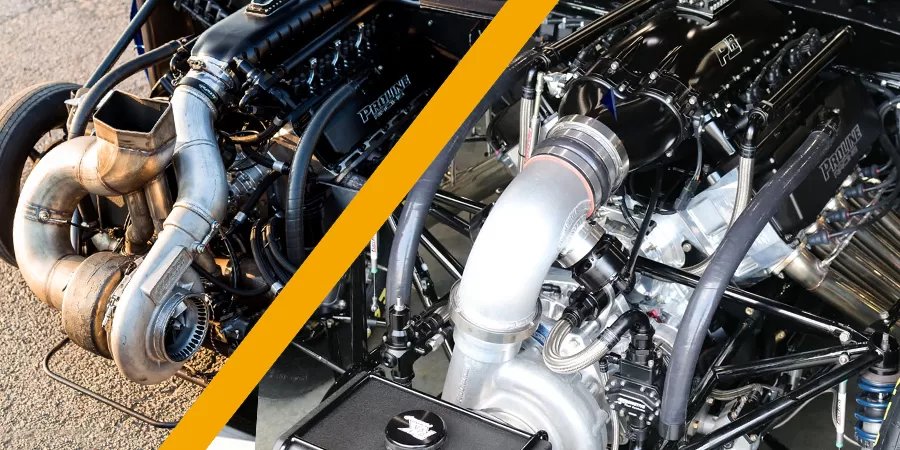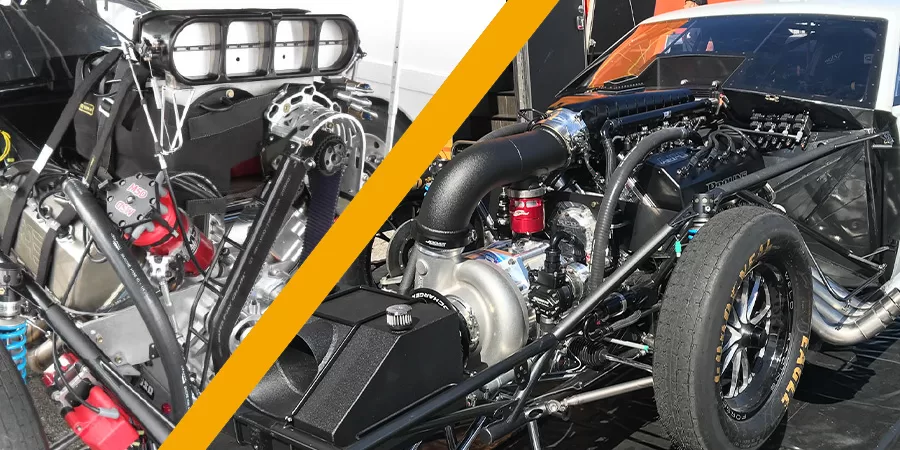Making the Switch to the ultimate Power Adder
- Switching from Nitrous to a ProCharger
- Switching from N/A to a ProCharger
- Switching from Turbo to ProCharger
- Switching from Roots blower to a ProCharger
Q: Switching from Nitrous to a ProCharger

FROM NITROUS (N2O) TO PROCHARGER
Thankfully, moving from a Nitrous (N2O) combo to a ProCharger is usually a fast swap and easier on the budget than others, since powertrain components can stay the same, including costly items like the exhaust system. Sometimes, even the rods/pistons can stay if the compression ratio is boost-friendly.
Compression Ratio most likely will needs changing – If the N2O motor was less than 13:1 static compression, chances are you will be okay to run them with the ProCharger, as long as you are running race gas or methanol in your race program. This also depends on your camshaft and engine builder/tuner’s preference. The less compression, the easier it will be to dial in your tune-up. It also opens the window to run other fuels such as E85, etc.
Camshaft most likely will needs changing – Normally, a N2O motor camshaft is too aggressive for a boosted motor. Since they usually run a low “LSA” and high “Overlap”, it can lead to the boost pressure being blown right out the tailpipes. This would cause the blower to work harder than it needs to in order to create a good boost pressure. However, those running a non-aggressive camshaft may still run the same cam.
TQ Converter reused to get started, probably changed later – The stall converter, or TQ converter, in an N2O car is usually a little too loose on the starting line for a boosted motor, and then too tight in the upper RPMs. However, you are able to run your current converter to get you started, get a baseline tune-up done, and make some test hits. Once you are ready, you will want to have your converter sent back to the manufacturer to get dialed in for use with a ProCharger, so the power and torque curve align more optimally.
Intake Manifold reused to get started, probably changed later – Lots of folks retain their intake manifolds and just block off the ports to their fogger nozzles, or remove the “plate” systems from their intakes. If running a blow-through carburetor, it will likely bolt onto the same intake. If running EFI, adaptor elbows are readily avilable to convert to a single throttle blade. Again, that’s going to be the tuner or engine builder’s preference.
Exhaust System can stay the same – Chances are the exhaust can stay the same, though folks do experiment with swapping from “zoomies” to “bull horns” and vice versa.
Q: Switching from N/A to a ProCharger

FROM N/A TO PROCHARGER
If an engine is a stock or “mild build,” chances are many things can stay the same. On the other hand, an engine that has been built for high-end or MAX effort heads-up drag racing, many items will need to be addressed/changed. That’s what the following talks about:
Compression Ratio most likely will need changing – In max effort, N/A builds the compression ratio if run on race fuels is usually too high for a forced induction engine. Most will have their piston manufacturer build them a set of pistons designed for forced induction to lower the compression, and still retain good quench areas, flame travel, and proper ring lands/rings for boost and higher HP levels.
Camshaft most likely will need changing – Normally, a max effort N/A engine will run fairly extreme amounts of overlap in their camshafts, which can lead to the boost from the ProCharger quite literally being blown right out the tailpipe. Ideally, when making the switch, a proper camshaft would be slid into the engine that is designed with forced induction in mind. This leads to better “boost” numbers, keeps the supercharger from working overtime, and results in higher HP levels.
Converter most likely will need changing – With all the epic amounts of horsepower coming from the addition of the ProCharger, chances are the torque converter will be far too loose. While it might seem to work at first, most customers would see elevated stall rpm’s as well as high slip numbers at wide open throttle. It’s best to have the torque converter changed to work correctly with the new power level, as well as the power curve of the ProCharger.
Intake Manifold reused to get started, probably changed later– Many N/A intake manifolds can be reused. If swapping from a carburetor to efi, fuel rails can be added. Or, if still maintaining a carb and going “blow-through,” a simple “hat” can be used to direct boost pressure through the carburetor. If the intake was matched to your heads and they are being retained, chances are your intake manifold will be retained as well.
Exhaust System can stay the same – Most of the time the exhaust system will work perfectly with the ProCharger, unless it is undersized for the power level once supercharged. Speak with your header manufacturer about what they suggest for your power level.
Q: Switching from Turbo to ProCharger

FROM TURBO(S) TO PROCHARGER
Since these engines are already set up to run forced induction, many items can remain the same. Other elements, like the exhaust system, will 100% have to change. The following recommendations reflect the most popular turbo-to-ProCharger swaps in the last few years. It is important to note that even though a ProCharger combo might show less power on the dyno, racers have commonly run their fastest passes or won more races once swapping to a ProCharger system. Again, this is due to the consistency and reliability of the ProCharger supercharger units.
Exhaust System will need to be changed – Since the exhaust system was once powering turbine wheel(s), there’s no way around the fact that the headers and exhaust system will now have to change. This doesn’t have to be high-dollar, custom stuff, since many header manufacturers offer off-the-shelf items that will pair perfectly with a ProCharged engine.
Camshaft reused to get started, probably changed later – Most who choose to make the switch to ProCharger will start off with their existing camshaft, because they already have their tune-up dialed in for boost. This allows them to concentrate on dialing in other items, like converter/suspension/timing tables. Down the road, it would be ideal to have your engine builder/cam manufacturer spec out a camshaft for a ProCharger.
Converter reused to get started, probably changed later – Much like the camshaft, the previous TQ converter can be reused to get you started. However, one of the best “bang for the buck” moments when making the switch from turbo(s) to ProCharger is when you move to a converter that has been selected specifically for a ProCharger
Compression Ratio can stay the same – Thankfully, engines already running other forms of forced induction have been built with the proper compression ratio in mind. Meaning, the crank/rods/pistons are all forged and designed for a forced-induction “effective” compression ratio. Obviously, the compression ratio can vary greatly depending on the amount of boost desired, the fuel type being used, and the camshaft selection.
Intake Manifold can stay the same – Chances are your intake manifold will stay the same. Most of the time these units already have the proper throttle bodies, carbs, or injector placements moving from turbo(s) to a ProCharger.
Q: Switching from Roots blower to a ProCharger

FROM SCREW/ROOTS TO PROCHARGER
Possibly one of the quickest swaps to ProCharger comes from positive displacement superchargers. This is because many items will remain the same, such as compression ratio and exhaust systems. Let’s break down the other items below:
Intake Manifold will need to be changed – Since positive displacement blowers are the lower intake, this is an item that will have to be replaced. We have seen some folks retain the lower intake and air-to-water intercooler, however, that is pretty rare, and a proper intake should be used.
Camshaft reused to get started, probably changed later – Many racers will keep the same camshaft to get them started, because their engine tune-up is based on the previous camshaft. A camshaft specific to a ProCharger should eventually be upgraded to dial in a max effort combo.
Converter reused to get started, probably changed later – While many will keep their converter when starting out, this should be changed as soon as possible. A converter that’s perfectly dialed in for its power adder is one of the “best bang for the buck” ways to drop E/Ts at the track.
Exhaust System can stay the same – Chances are the exhaust system will not need to be changed if properly sized for the power level.
Compression Ratio can stay the same – Since the engine was already running boost, chances are the pistons and rods will remain the same. A ProCharger may impose a slight rise in compression, since ProChargers are known to be more efficient with cool charge air temps and don’t require ultra-low compression ratios.
